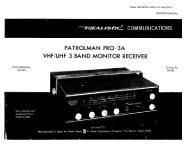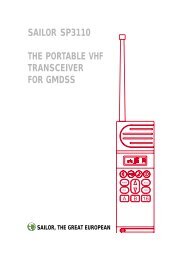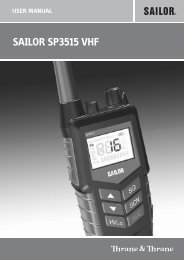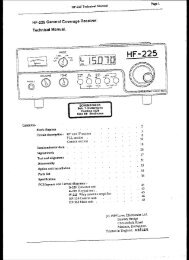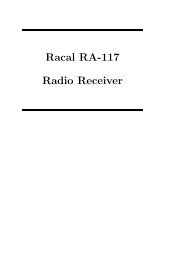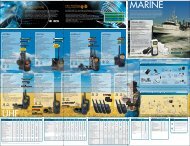MFJ-8100K Manual
MFJ-8100K Manual
MFJ-8100K Manual
You also want an ePaper? Increase the reach of your titles
YUMPU automatically turns print PDFs into web optimized ePapers that Google loves.
From the late 1970's through the '80's, as consumer electronics and new ham radio<br />
equipment became more sophisticated so very rapidly, interest declined not only in<br />
regenerative receivers, but also in kit-building and even in shortwave radio listening. One<br />
or two generations of Americans simply missed out on the thrill and satisfaction of<br />
building and understanding a simple radio set which could receive signals from anywhere<br />
in the world.<br />
Back to Today . . . and the Future!<br />
Your <strong>MFJ</strong>-8100 is a much better receiver than the "classic'' radio sets which attracted<br />
several generations of Americans to the excitement of radio and electronics. In fact, its<br />
basic performance is superior to many of the simplest superhet receivers which were<br />
considered such a great step beyond one's first regenerative set.<br />
The reason why this receiver works so well is because there is much more precision in<br />
today's engineering designs and the manufacturing of electronic parts. We looked<br />
carefully at the practical problems associated with yesteryear's technology, and we used<br />
TODAY'S know-how and components to solve the problems.<br />
A Simplified Explanation of How It Works<br />
When you're ready, please explore the technical explanation of your receiver in<br />
"Introduction No. 2.'' In the meantime, you can peek at the schematic diagram and picture<br />
the receiver in three basic sections:<br />
A. Detector-Oscillator (Q1,Q2)<br />
B. RF amplifier (Q3)<br />
C. Audio amplifier (IC1)<br />
To put it very simply, a detector converts radio energy from an antenna into audio energy,<br />
i.e., a sound which you can hear. A detector can be as simple as a crystal diode, which is<br />
the heart of the simple "crystal radio.'' If you've ever heard unwanted radio signals on a<br />
stereo, telephone, PA system or intercom, you can assume that some part of those devices<br />
has acted as a detector to convert a nearby CB, taxi or broadcast signal into intelligible<br />
sound. (This process of detection is also referred to as demodulation.)<br />
In the following explanation, the words regeneration, feedback and oscillation all mean<br />
approximately the same thing.<br />
By itself, a detector can interpret or demodulate only very strong signals such as a nearby<br />
AM radio station. However, the process of regeneration can make a detector much more<br />
sensitive by turning the detector into an "oscillating amplifier.'' The regeneration circuit<br />
repeatedly feeds the detected signal back to the input which boosts its strength many<br />
hundreds of times. This feedback process must be carefully controlled, which is the<br />
function of the regeneration control.<br />
4





